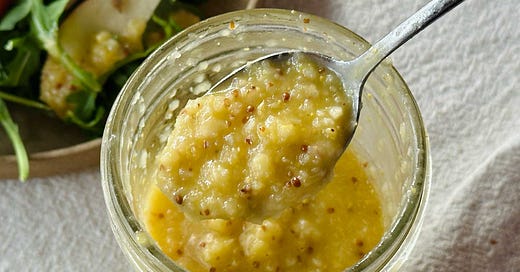You're tossing the best part of the lemon
When life gives you lemons, make a tangy zero-waste treat
Hey there, and welcome back to Cool Beans! We’re in peak food waste season, the special time of year when household castoffs jump by 25%. We’re also just around the corner from what I like to call “fancy citrus season,” and I’m looking forward to seeing Meyer lemons, kumquats, blood oranges, pomelos, and other rarer varieties of these juicy orbs at the market. While I have no problem quickly consuming short-season citrus in the chillier months, having a surplus of lemons is a year-round problem for me and, I imagine, other home cooks who reflexively grab one (or three) every time they’re at the store.
Common lemons are cheap and cheerful, yet often overlooked for the valuable ingredient that they are. From baking and cooking to DIY pantry projects (preserved lemons!), the golden child of the citrus world has a myriad of uses both inside and out. Sadly, most recipes either tell us to zest or juice them, relegating the majority of the fruit to the bin. That’s why I’m squeezing out two totally different ways to use the entire fruit—skins, juice, pith, and all—so that next time life hands you lemons, you’ll know exactly what to make. Today, it starts with a cake.
The review: A pound (of lemons) cake
I first came across Nigella Lawson’s clementine cake in her cookbook, How To Eat, in 2018. The recipe, which has been shared and adapted all over the internet, is notorious for its blissfully short ingredients list and intriguing method of puréeing entire boiled citrus. Since today is all about the lemons, I decided to swap them for the clementines to make this uber-famous flourless cake.
Though this confection only has five ingredients (citrus, eggs, sugar, almond flour, and baking soda), it requires a bit of patience. The entire batter is made in a food processor, but first you have to boil the citrus for two hours to get it soft enough to purée. The other time-consuming aspect is the recommended 12-hour post-bake waiting period before you taste the spoils. Lawson insists that the sponge gets better as it ages. I treated this as a small science project, eating a slice for three days straight. I can confirm that the cake does get more moist, and sweeter somehow, the longer it sits.
Check out Nigella Lawson’s original clementine cake recipe.
Even with the boiling time, I found this recipe far easier than your typical lemon cake. For starters, I didn’t have to measure out zest or juice. I also didn’t need any whisks or mixing bowls as the whole thing gets made in the food processor. Flavorwise, it tastes like a cross between cake and marmalade. The lemons don’t break down completely in the food processor, which made me worry they’d make for a bitter cake, but the exact opposite happened. They mingled with the sugar to create little candied lemon bits in every bite.
I can’t think of a better way to use up lemons than baking a cake, but this is far from the only time you’ll catch me boiling this citrus staple. Cooking them this way is also an excellent shortcut substitute for preserved lemons—which can take a month to make otherwise. I also appreciate that this recipe doesn’t call for you to juice a bunch of fruit or even break out a microplane.
Preservation tip: While lemons look adorable in a fruit bowl on the counter, they will last two weeks or more in the fridge. Store them in a resealable, preferably reusable, plastic bag in the icebox. Zest and juice will last for three months or more in the freezer.
If for some reason, however, you do find yourself with a surplus of juiced lemon hulls, toss them with sugar for a no-cook syrup that’ll liven up your cocktail or spruce up pancakes. Or, use a potato peeler to remove the skins (best done before juicing) to make lemon sugar, which you can swap for regular sugar in baking or use to make a doubly citrusy lemon curd. But my favorite way to utilize the whole fruit is the simplest recipe of all: the humble vinaigrette.
The recipe: This dressing will sucker-punch your taste buds out of hibernation
Putting lemon juice in salad dressing is basic to say the least, but how often do we use the entire fruit? This recipe does just that (minus the seeds) to make a golden, zesty dressing to drizzle over greens, roasted vegetables, heck, I even like it on oysters.
There’s a whole spectrum of flavor within a lemon, the bitterness from the skins and sweet-tartness from the juice. This dressing brings them all together and balances them with honey and mustard. It’s a real shock to your palate in these cold winter months, but it’s delicious to use all year long. Grab your lemons and a jar. Let’s get shaking.
Whole Lemon Vinaigrette
Makes 1 cup






